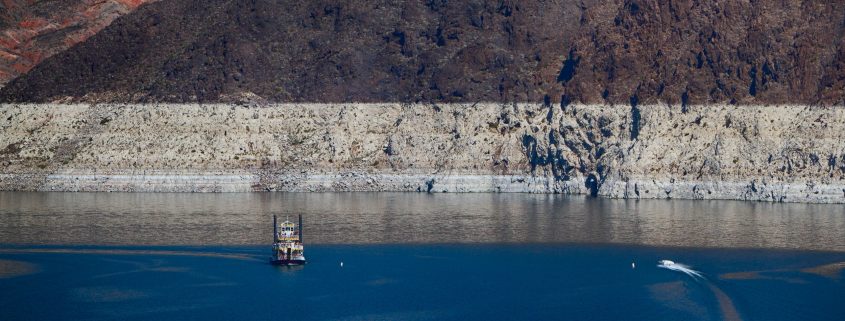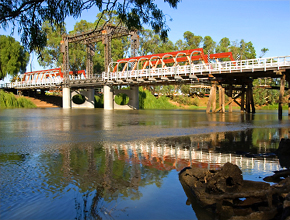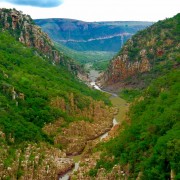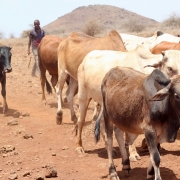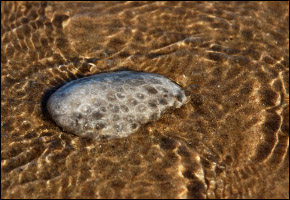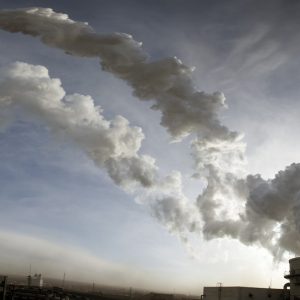Lake Mead Record Low Reflects Changing American West
In drier conditions, the desire to use more water confronts the need to use less.
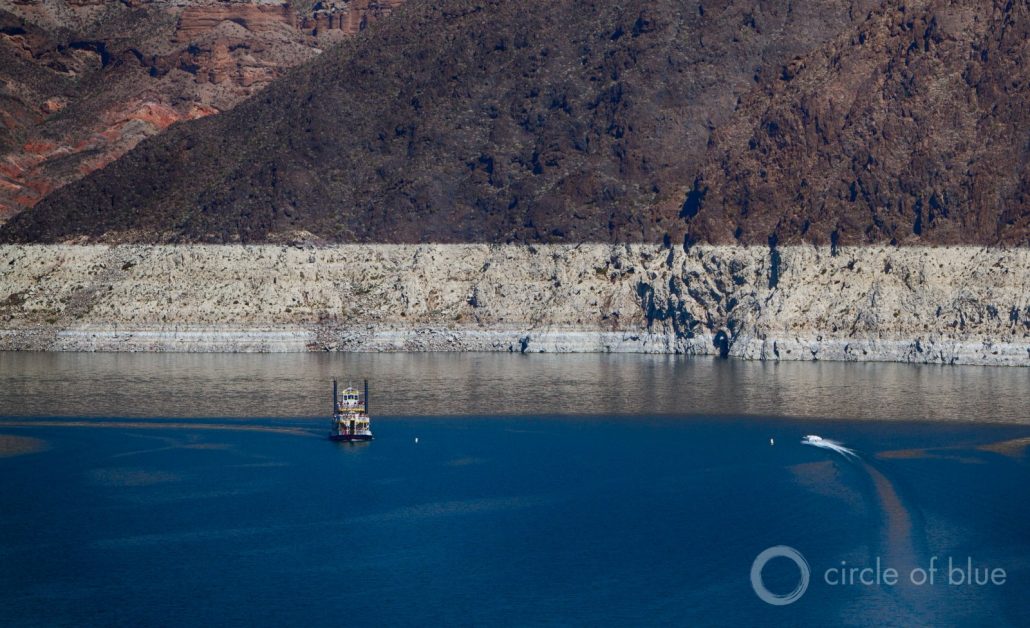
Mineral deposits on the canyon walls show where Lake Mead water levels used to touch. The big reservoir set a new record low on May 18, 2016. Photo © J. Carl Ganter / Circle of Blue
By Brett Walton
Circle of Blue
Nervous investors, concerned about their nest eggs, will check the financial markets. Is the New York Stock Exchange up? What direction is the NASDAQ moving?
For people living in the American Southwest, water levels in reservoirs play the same role. And Lake Mead is the blue chip, the biggest, most consequential, most widely watched piece in the game. When water levels are up, spirits are unburdened. People are confident in their place in the desert.
But when water levels are down, a cloud of worry creeps in, bringing questions about the fragility of life in the drylands. Down, way down, is where Lake Mead is today. On May 18, just before sunset, the surface elevation of America’s largest reservoir crossed the 1,074.7 foot threshold, setting a new record low for the iconic water body. The next day another record low was set. In fact, every day since then the reservoir has broken the old mark. The Bureau of Reclamation, the federal agency that manages Mead, expects the daily decline to continue through June. The reservoir is 36 percent full — or, to look at it another way, 64 percent empty.
Public worry has evolved to a transcendent regional anxiety, and moving the Southwest to action. Communities are investing in new equipment and partnerships in order to adapt to the basin’s new math. Las Vegas spent nearly $US 1.5 billion to construct a water intake at the bottom of the lake and a pumping station to lift the water. Los Angeles, which is outside the basin but gets Colorado River water delivered by canal, is cutting reliance on imported water. Phoenix and Tucson, often viewed as ideological opposites, agreed in 2014 to coordinate the use of their water facilities, to maximize storage and minimize cost. Most remarkable of all, California — which holds the most power in the basin and the most secure rights — is in talks with Arizona and Nevada on a new conservation agreement. That agreement would reduce California’s annual take of the Colorado River for the first time.
Mead started to tumble at the turn of the 21st century, when drier conditions took hold in the Colorado River Basin. With every new annual low the sense of urgency in the seven-state, two-country watershed grew. A landmark 2007 agreement worked out a formula for declaring a shortage in the lower basin states of Arizona, California, and Nevada, and for restricting water withdrawals from Mead. The three states are now working to delay that day of reckoning by keeping more water in the big reservoir.
A reckoning is imminent. The climate and the Colorado are drying. There are proposals from the upper basins states — Colorado, New Mexico, Utah, and Wyoming — to take more water out of the river, which will reduce flows into Lake Mead. Utah filed a federal application earlier this month for a pipeline to draw water from Lake Powell, located upstream from Mead.
Topography is another complication. Because the canyon that holds the lake is v-shaped, water levels fall more quickly near the bottom. Every one-foot drop in elevation equates to 80,000 acre-feet of water lost — an acre-foot is 326,000 gallons — or more water than San Francisco uses in a year. It all adds up to a long-term forecast of diminishing supplies.
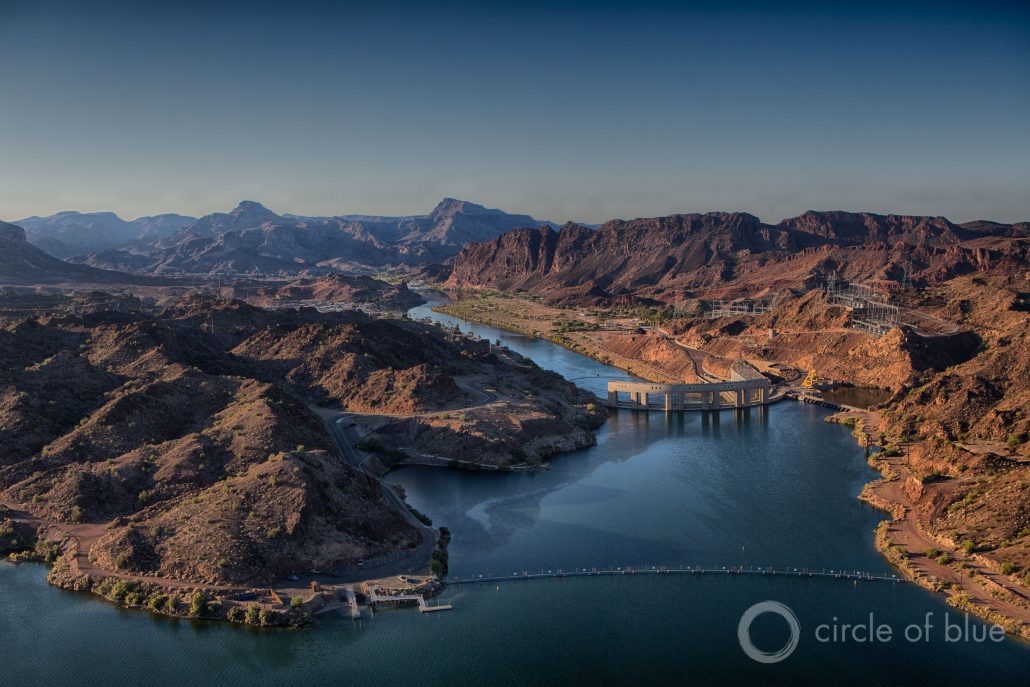
Downstream of Lake Mead, the Colorado River flows into Lake Havasu, a reservoir on the California-Arizona border. Photo © J. Carl Ganter / Circle of Blue
There is no time to waste. The timetable for action is accelerating. The record lows are coming sooner in the season – July 9, 2014; June 23, 2015; May 18, 2016. All eyes are on the number 1,075. If Mead’s elevation in August is projected to be lower than 1,075 feet at the start of the following year, then a shortage would be declared. The Bureau of Reclamation estimates a 56 percent chance of a lower basin shortage by 2018. This means water cuts from the Colorado for Arizona and Nevada (and potentially for California, depending on how the ongoing negotiations shake out).
Despite the gloomy forecast, there are encouraging signs of camaraderie. A shortage would have come sooner if not for concerted conservation efforts in recent years. A $US 11 million program that was agreed to in 2014 is paying for conservation projects that bank the saved water in Mead. A similar program is taking place in the upper basin.
All told, a shortage will not decimate the basin. Its punch is more psychological at the moment than physical. But it is symbolic of the difficulty ahead if Lake Mead drops below 1,050 feet, or 1,025 feet, or even near the 950-foot level where hydropower generation would cease. The sternest tests for the Colorado River Basin — both political and hydrological — are still to come.
Brett writes about agriculture, energy, infrastructure, and the politics and economics of water in the United States. He also writes the Federal Water Tap, Circle of Blue’s weekly digest of U.S. government water news. He is the winner of two Society of Environmental Journalists reporting awards, one of the top honors in American environmental journalism: first place for explanatory reporting for a series on septic system pollution in the United States(2016) and third place for beat reporting in a small market (2014). He received the Sierra Club’s Distinguished Service Award in 2018. Brett lives in Seattle, where he hikes the mountains and bakes pies. Contact Brett Walton

